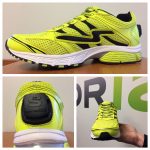 Whilst most wearable technologies have been bits of hardware, such as watches, there are a growing number of tools that are built into clothing itself.
Whilst most wearable technologies have been bits of hardware, such as watches, there are a growing number of tools that are built into clothing itself.
For instance, sweat bands have been developed to monitor our dehydration levels based upon the sweat it collects as we exercise. LumoRun have developed a range of ‘smart clothing’ that monitor your fitness activity, with IBM also teaming up with Under Armor to do similar work.
More advanced technologies aim to measure more than just your activity. For instance, one project aims to detect your fatigue levels for you, whilst a smart compression sleeve does everything from sleep monitoring to ECG provision.
Sensing fitness
An interesting company at the forefront of this movement are Sensoria Fitness, who have developed sensor technology that can be embedded into anything from socks to trainers, sports bras to running tops.
Their latest products are a pair of ‘smart socks’ that feature three textile sensors built into the sole. The sensors capture a number of key data streams relevant for runners, including cadence and gate.
The data is sent to an accompanying app, which provides a range of analytics and coaching support to help the athlete as they workout. By decoupling the analysis component from the measurement component, it makes it easy for athletes to use multiple garments to perform the same task.
The focal point of the app is a smartcoach, known as Mara, which can provide athletes with a verbal commentary of their run. So, for instance, you might get updates of your mile times to monitor your pacing. Mara is capable of reporting on any metric captured, including the usual speed and distance, but also cadence, foot landing and heart rate zone.
The app is designed to work alongside whatever else is playing on your phone, so you can listen to your favorite music, and the volume will adjust itself whenever Mara needs to ‘talk’ to you.
What’s more, the device is even capable of recommending a change of footwear based upon your usage patterns, with the platform connected up with a range of manufacturers. The company claim that they can match the ideal footwear for your particular style based upon the data generated as you run.
Health benefits
Whilst fitness applications such as these are undoubtedly pretty cool, I think there is even more potential for such devices to shake up the healthcare industry.
Sensoria Core is a non-mission specific piece of electronics that can be embedded into any garment to instantly make it ‘smart’. The company have worked with a number of medical research teams to include this kind of sensing into their work.
For instance, a team from the University of Arizona have been working with the company to better monitor diabetes related wounds.
The study, which was published recently, explored Diabetic Foot Ulcers (DFUs), and how textile-based sensing could be used to monitor pressure offloading. For diabetes patients, there is a 25% chance of developing DFUs during their lifetime. The risks are severe, with 50% developing an infection, and around 20% losing a limb as a result.
Crucial to managing DFUs effectively is the ability to monitor plantar pressure, with the lower the pressure, the less at risk the patient is. The researchers utilized Sensoria Core to embed a pressure sensor into a stretchable band, with a dashboard then informing the clinician of the plantar pressure of the wearer.
With healthcare systems so stretched financially around the world, the challenge will be to develop such systems for much the same price as existing garments. It does provide a fascinating glimpse into the future however.
Check out the video below to learn more about Sensoria Core.